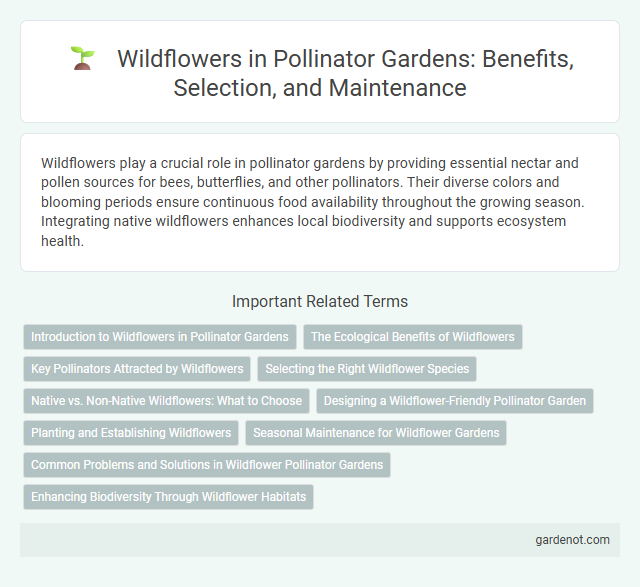Wildflowers play a crucial role in pollinator gardens by providing essential nectar and pollen sources for bees, butterflies, and other pollinators. Their diverse colors and blooming periods ensure continuous food availability throughout the growing season. Integrating native wildflowers enhances local biodiversity and supports ecosystem health.
Introduction to Wildflowers in Pollinator Gardens
Wildflowers are native plants that provide essential nectar and pollen resources to pollinators such as bees, butterflies, and hummingbirds. Their diverse bloom periods support pollinator activity throughout the growing season, enhancing biodiversity and ecosystem health. Incorporating wildflowers in pollinator gardens promotes habitat restoration and improves the resilience of local pollinator populations.
The Ecological Benefits of Wildflowers
Wildflowers play a crucial role in supporting pollinator populations by providing diverse nectar and pollen sources essential for bees, butterflies, and other insects. Their deep root systems enhance soil health, prevent erosion, and improve water infiltration, contributing to a resilient ecosystem. By fostering biodiversity, wildflowers help maintain balanced food webs and support habitat for native wildlife within pollinator gardens.
Key Pollinators Attracted by Wildflowers
Wildflowers attract key pollinators such as bees, butterflies, and hummingbirds, which play a vital role in ecosystem health and plant reproduction. Native wildflower species provide essential nectar and pollen resources that support these pollinators' life cycles and enhance biodiversity. By fostering habitats with diverse wildflower varieties, pollinator gardens can sustain robust populations of critical species like honeybees (Apis mellifera) and monarch butterflies (Danaus plexippus).
Selecting the Right Wildflower Species
Selecting the right wildflower species for a pollinator garden involves choosing native plants that bloom throughout the growing season to provide continuous nectar and pollen sources. Species such as Echinacea, Black-eyed Susan, and Milkweed are highly attractive to bees, butterflies, and hummingbirds, supporting diverse pollinator populations. Soil type, sunlight exposure, and local climate conditions are critical factors to ensure wildflower establishment and optimal growth in pollinator habitats.
Native vs. Non-Native Wildflowers: What to Choose
Native wildflowers support local ecosystems by providing essential nectar and pollen for indigenous pollinators such as bees, butterflies, and hummingbirds. Non-native wildflowers may offer vibrant colors but can compete with native species and potentially disrupt habitat balance. Choosing native wildflowers enhances biodiversity, promotes pollinator health, and ensures sustainable garden growth in pollinator gardens.
Designing a Wildflower-Friendly Pollinator Garden
Selecting native wildflower species tailored to local climate and soil conditions enhances the attractiveness and sustainability of a pollinator garden. Incorporating a diverse range of bloom times ensures a continuous nectar and pollen supply for bees, butterflies, and other pollinators throughout the growing season. Strategic planting in clusters and providing sunlit, sheltered spaces supports pollinator activity and promotes biodiversity within the garden ecosystem.
Planting and Establishing Wildflowers
Planting wildflowers in a pollinator garden requires selecting native species like Echinacea purpurea and Asclepias tuberosa, known for attracting bees, butterflies, and hummingbirds. Preparing well-drained, nutrient-poor soil mimics natural habitats, enhancing seed germination and plant establishment over time. Regular watering during the first growing season ensures root development, while minimal disturbance supports long-term sustainability and biodiversity.
Seasonal Maintenance for Wildflower Gardens
Seasonal maintenance for wildflower gardens includes regular weeding to prevent invasive species from outcompeting native blooms and timely pruning to promote healthy growth and prolong flowering periods. Mulching in early spring helps retain soil moisture and suppress weeds, while deadheading spent flowers in late summer encourages continuous blooming. Monitoring for pests and diseases throughout the growing season ensures the vibrant health and sustainability of the pollinator-attracting wildflowers.
Common Problems and Solutions in Wildflower Pollinator Gardens
Common problems in wildflower pollinator gardens include poor soil quality, invasive weeds, and lack of native plant diversity, which can reduce pollinator habitat and nectar sources. Solutions involve testing and amending soil to improve fertility, regularly removing invasive species to prevent competition, and selecting a variety of native wildflowers to support diverse pollinator populations throughout the growing season. Proper site preparation and ongoing maintenance are essential for sustaining healthy pollinator-friendly wildflower gardens.
Enhancing Biodiversity Through Wildflower Habitats
Wildflower habitats play a crucial role in enhancing biodiversity by providing essential nectar and pollen resources for a wide variety of pollinators, including bees, butterflies, and hummingbirds. These diverse plant assemblages support not only pollinators but also beneficial insects, birds, and small mammals, creating a balanced ecosystem. Establishing wildflower gardens increases genetic plant diversity and promotes resilience against environmental stresses, contributing significantly to ecological health and sustainability.
Wildflower Infographic

 gardenot.com
gardenot.com